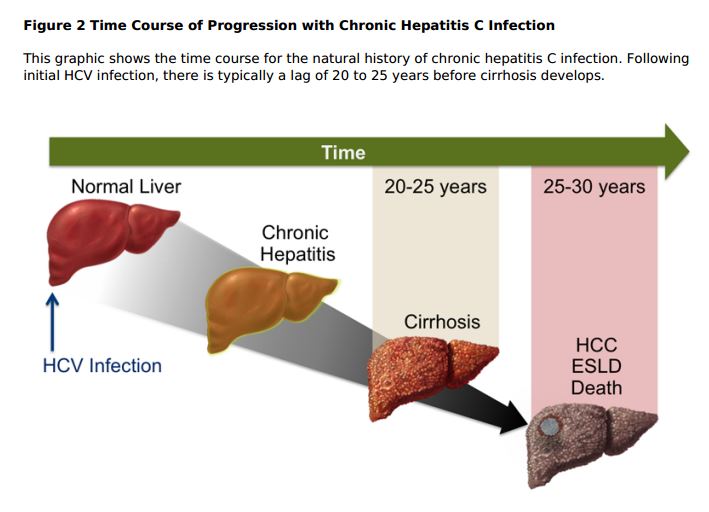The chart below is from Reference (1):
All of the following figures and text are from Reference (2)
Summary Points
- Approximately 75 to 85%, of persons infected with HCV will develop chronic infection.
- Factors associated with spontaneous clearance of HCV include younger age at infection, female sex, race other than African American, IL-28B CC genotype, and symptomatic acute infection.
- The natural history of HCV infection has not been clearly defined because of the lack of prospective studies. Our understanding of the natural history of hepatitis C is primarily based on retrospective studies.
- Among those who develop chronic HCV infection, approximately 20 to 25% will develop cirrhosis 20 to 30 years after acquiring HCV infection.
- It is impossible to predict the rate of fibrosis progression in an individual early on in their infection.
- Factors associated with an increased rate of fibrosis progression include acquisition of HCV at an older age, increased age independent of duration of infection, male sex, heavy alcohol use, heavy marijuana use, coinfection with HIV or HBV, steatosis and insulin resistance.
- Individuals who develop hepatitis C-related cirrhosis have approximately 1 to 4% risk per year of developing HCC and a similar risk of developing end-stage liver disease. Overall, approximately half of those who develop cirrhosis will die from their liver disease.
Resources:
(1) Evaluation and Prognosis of Patients with Cirrhosis, July 6, 2016, from Hepatitis C Online
(2) Natural History of Hepatitis C Infection from Hepatitis C Online
Hepatitis C Online is a free educational web site from the University of Washington.
The site is a comprehensive resource that addresses the diagnosis, monitoring, and management of hepatitis C virus infection.







